

Live From Mars was active July 1996-December 1997.
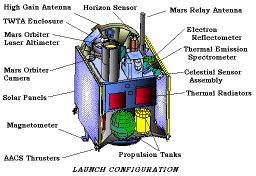
|
The wide range of instruments on Mars Global Surveyor reflects the various objectives of the mission. Their tasks range from imaging Mars to searching for an ancient magnetic field. Four of the instruments are attached to the side of the spacecraft that always faces the surface of Mars: the Mars Orbiter Camera (MOC), the Mars Orbiter Laser Altimeter (MOLA), the Electron Reflectometer (ER), and the Thermal Emission Spectrometer (TES). The Magnetometer (MAG) is attached to the ends of the solar arrays, which are always pointing toward the sun. In order to maintain the proper temperature the instruments will be covered in thermal blankets.
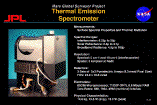
|
This instrument collects data on the infrared radiation emitted from the surface of Mars. The data will provide scientists with considerable information related to the surface and weather of Mars. TES will examine the distribution of temperatures across the surface of Mars, as well as the distribution of rocks. The temperature during different times of the day will be recorded and the types of rocks and minerals that form the landscape will be determined. Questions may finally be answered about the formation of clouds and the origin of the dust that is so familiar to Mars.
For more information visit the Arizona State University Mars TES page.
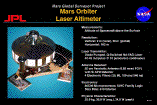
|
The main task of this instrument is to generate a topological map of the surface. To achieve this, MOLA will transmit an infrared beam of light to the surface of Mars. By measuring the time it takes the light to return from the surface, scientists will be able to tell the distance between the spacecraft and the point on the surface. Scientists can replicate these measurements across Mars and use that information to specify the elevations over the planet.
The MAG/ER will seek and characterize, if present, the strength of a magnetic field on Mars. It will also delve into the history of Mars by searching for evidence of an ancient magnetic field. Magnetometers detect trapped charged particles around the planet. The Earth's own Van Allen radiation belts hold positively charged hydrogen ions and electons, which originated from the sun, but have been trapped by the Earth's magnetic field. It is this type of phenomena on Mars that scientists seek but in smaller quantities. It may tell researchers what Mars was like during a time when it had a stronger magnetic field.
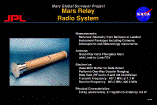
|
The radio science instrument utilizes data from its telecommunication system and onboard ultrastable oscillator to detect and map variations in Mars' gravity field. It senses when the spacecraft changes speed as it journeys around Mars. The changes in speed indicate a change in the strength of the magnetic field around Mars.
By using occultation data to measure the atmosphere's effect on radio signal strength, an atmospheric map will be generated. Each time the spacecraft starts moving behind Mars or when it comes out from behind the planet, the radio signals from the spacecraft will be travelling through Mars' atmosphere. The changes in the radio signal resulting from the atmosphere will reveal the current temperature and pressure.
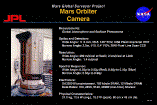
|
The camera will produce a low-resolution global image of Mars daily. Medium- and high-resolution images will be taken of selected locations. MOC contains a wide-angle lens, with a resolution of about 7.5 km, for producing pictures similar to those taken from weather satellites. Its narrow-angle lens, with a resolution of about 2-3 meters, will show surface features such as boulders and sand dunes. These data will be useful in determining landing sites for future missions.
Onboard Mars Global Surveyor is a radio receiver/transmitter that can receive data from the landers sitting on Mars and relay the data back to Earth. The Surveyor will continue to serve as an in-orbit relay for future Mars missions.

![]()